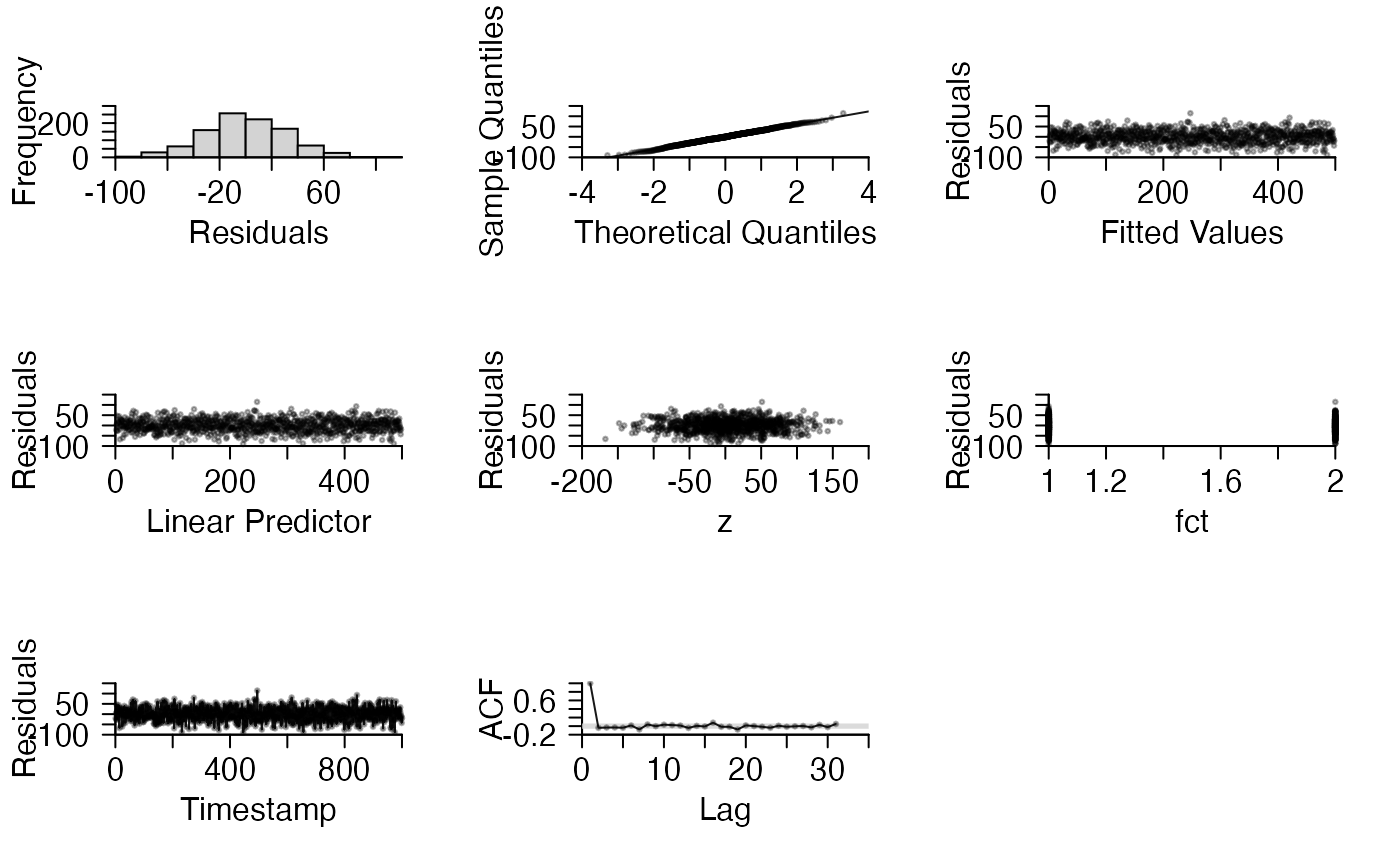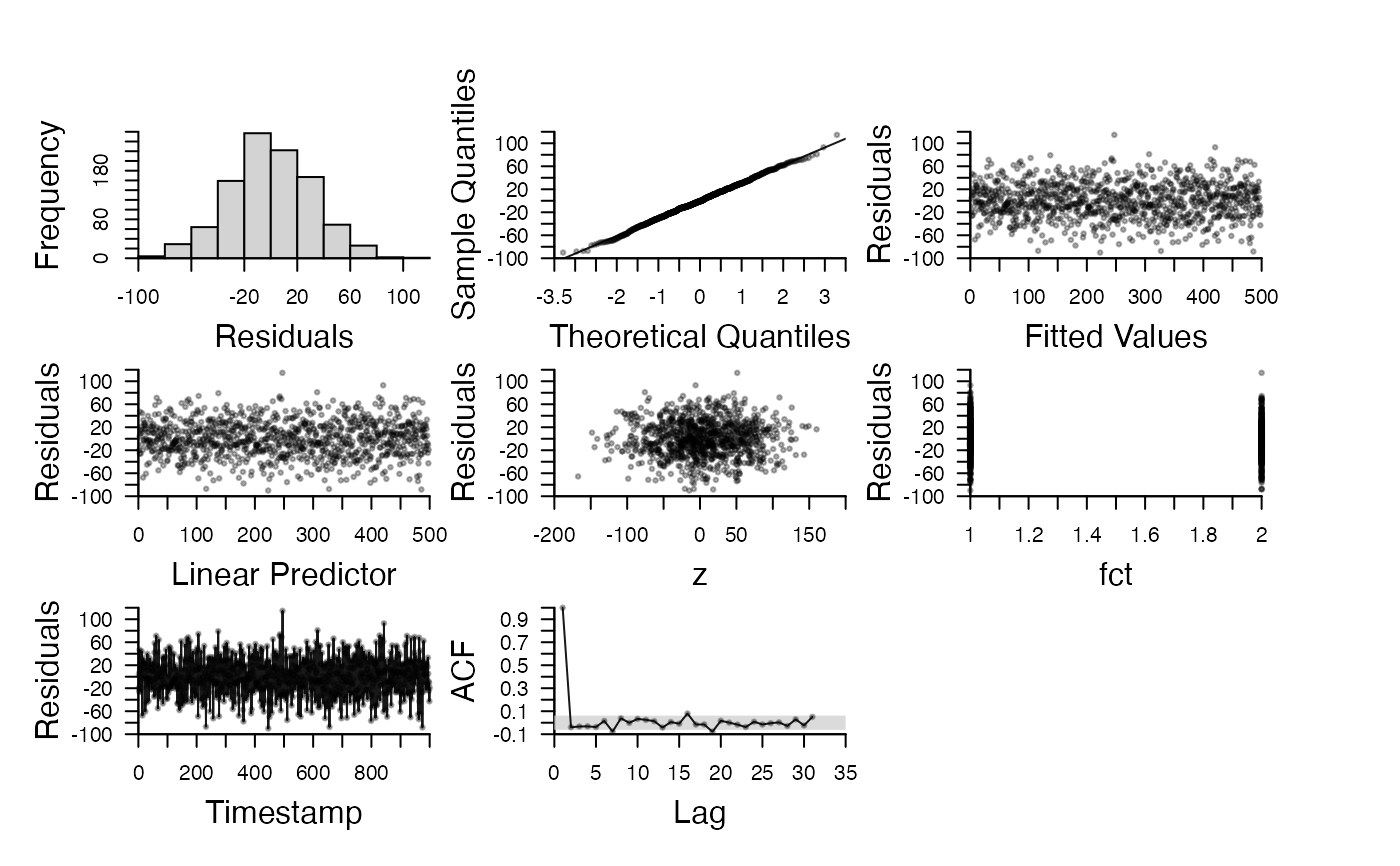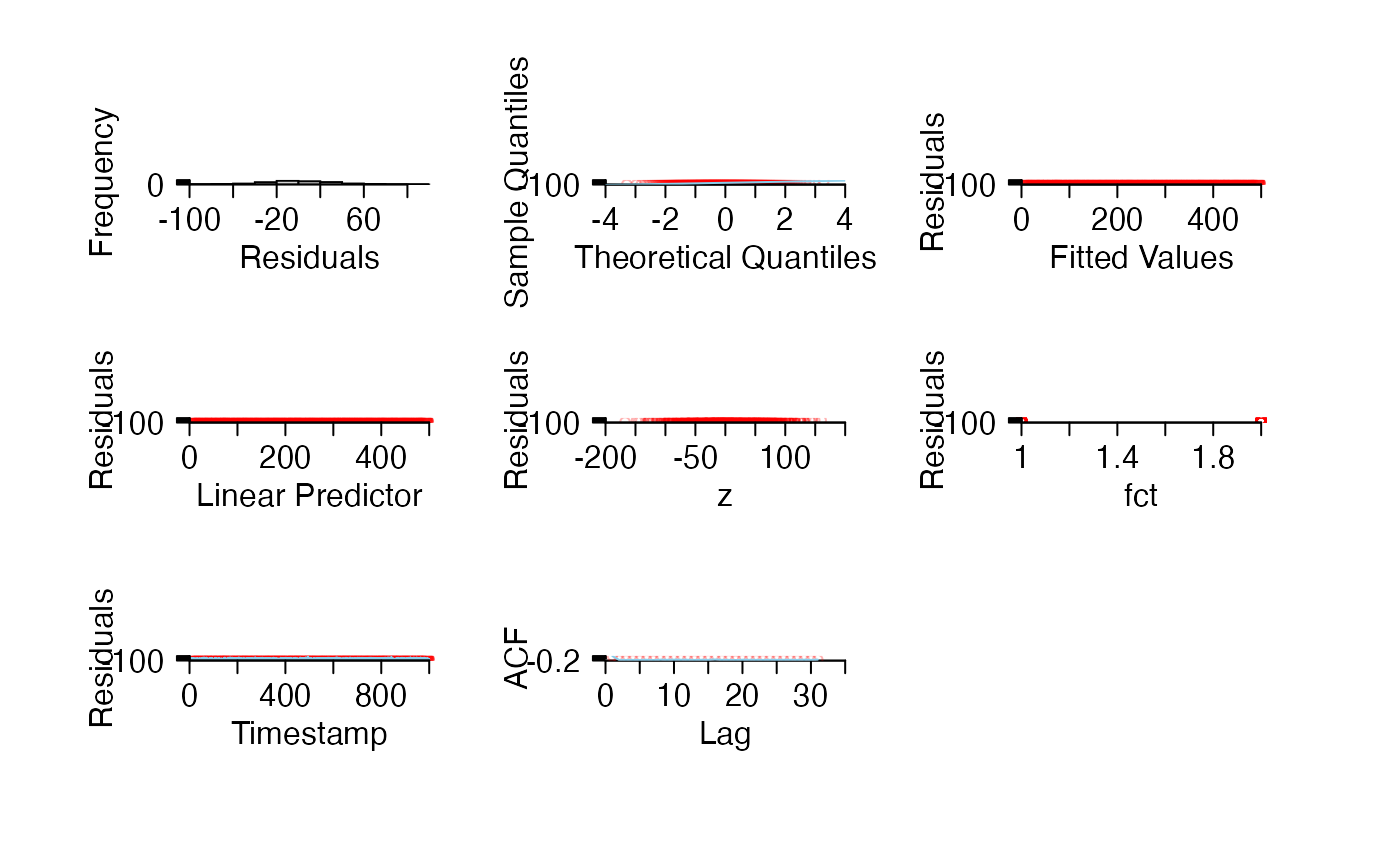This function produces (pretty) diagnostic plots of residuals. Plots can include standard diagnostic plots (i.e., residuals versus fitted values, residuals versus the linear predictor, a histogram of residuals and quantile-quantile plots), diagnostic plots for time series (i.e., time series of residuals and autocorrelation functions of residuals); and other helpful plots (i.e., residuals against factor levels/continuous covariates). For large datasets, these plots can be produced for random subsets of the data to aid interpretation.
pretty_residuals( residuals, fv = NULL, lp = fv, vars = NULL, timestamp = NULL, timestamp_fct = NULL, timestamp_fct_level = NULL, dat = NULL, plot = 1:7, rand_pc = NULL, plot_rand_pc = 3:6, points_args = list(pch = 21, col = scales::alpha("black", 0.3), bg = scales::alpha("black", 0.3), cex = 0.5), lines_args = list(col = scales::alpha("black", 0.9)), pretty_axis_args = list(side = 1:2, pretty = list(n = 5), control_axis = list(las = TRUE, cex.axis = 1.5)), mtext_args = list(`1` = list(list(side = 1, text = "Residuals", line = 2.5), list(side = 2, text = "Frequency", line = 2.5)), `2` = list(list(side = 1, text = "Theoretical Quantiles", line = 2.5), list(side = 2, text = "Sample Quantiles", line = 2.5)), `3` = list(list(side = 1, text = "Fitted Values", line = 2.5), list(side = 2, text = "Residuals", line = 2.5)), `4` = list(list(side = 1, text = "Linear Predictor", line = 2.5), list(side = 2, text = "Residuals", line = 2.5)), `5` = lapply(vars, function(var) { list(list(side = 1, text = var, line = 2.5), list(side = 2, text = "Residuals", line = 2.5)) }), `6` = list(list(side = 1, text = "Timestamp", line = 2.5), list(side = 2, text = "Residuals", line = 2.5)), `7` = list(list(side = 1, text = "Lag", line = 2.5), list(side = 2, text = "ACF", line = 2.5))) )
Arguments
| residuals | A numeric vector of residuals from a model. |
|---|---|
| fv | A numeric vector of fitted values from a model. |
| lp | A numeric vector which defines the values of the linear predictor from a model. |
| vars | A character vector which defines the names of variables in a dataframe (see |
| timestamp | A character which defines the name of a variable in |
| timestamp_fct | (optional) A character which defines the name of a variable in |
| timestamp_fct_level | An identifier of the independent time series in |
| dat | A dataframe containing columns named as specified in |
| plot | A numeric vector (1:7) which defines the plots to produce (see Details, below). |
| rand_pc | A number which defines a percentage of residuals to plotted. If specified, a random subset of residuals, chosen according to a uniform distribution, are plotted. This is useful for some plots of residuals (e.g. residuals versus fitted values) which can be difficult to interpret with large datasets. However, note that some plots of residuals (e.g. quantile-quantile plots) respond poorly to selecting samples of residuals, and this option is not recommended in those cases - see |
| plot_rand_pc | A numeric input which defines which plots will use thinned residuals. This plots 3 - 6 by default (plots 1, 2 and 7 are still interpretable with large amounts of data.) The residual plot that corresponds to each plot number is explained in Details. |
| points_args | A named list of arguments that is passed to |
| lines_args | A named list that is passed to |
| pretty_axis_args | A named list of arguments that is passed to |
| mtext_args | A named list of arguments that is passed to |
Value
Diagnostic plots of residuals.
Details
Seven types of diagnostic plots can be produced: 1, a histogram of residuals; 2, a quantile-quantile plot; 3, residuals versus fitted values; 4, residuals versus linear predictor; 5, residuals against one or more user-defined variables; 6, residuals against a time stamp/index; 7, an autocorrelation function of residuals. pretty_axis is used to control axes. This can be customised but changes affect all plots. Axis labels are implemented with mtext via mtext_args to enable maximum user control over axes. The graphical characteristics of points and lines are specified in points_args and lines_args, respectively, and changes to these arguments affect all relevant plots. This implementation reflects a balance between user flexibility and simplicity.
Author
Edward Lavender
Examples
#### Simulate and model data set.seed(1) x <- 1:1000 y <- rnorm(length(x), x*0.5, 30) dat <- data.frame(x = x, y = y) dat$fct <- sample(1:2, size = nrow(dat), replace = TRUE) dat$z <- rnorm(nrow(dat), dat$x*0.01, 50) m1 <- lm(y ~ x, data = dat) #### Plot residuals using default options pp <- graphics::par(mfrow = c(3, 3)) pretty_residuals(residuals = stats::resid(m1), fv = fitted(m1), lp = fitted(m1), vars = c("z", "fct"), timestamp = "x", dat = dat, )#>#### Customisation of axes is via pretty_axis_args; changes affect most plots. pp <- graphics::par(mfrow = c(3, 3), oma = c(3, 3, 3, 3), mar = c(2, 2, 2, 2)) pretty_residuals(residuals = stats::resid(m1), fv = fitted(m1), lp = fitted(m1), vars = c("z", "fct"), timestamp = "x", dat = dat, pretty_axis_args = list(side = 1:2, pretty = list(n = 10)) )#>#### Customisation of graphics is via points_args() and lines_args() # ... which are implemented for the relevant plots: pp <- graphics::par(mfrow = c(3, 3), oma = c(3, 3, 3, 3)) pretty_residuals(residuals = stats::resid(m1), fv = fitted(m1), lp = fitted(m1), vars = c("z", "fct"), timestamp = "x", dat = dat, points_args = list(col = scales::alpha("red", 0.3)), lines_args = list(lwd = 1, col = "skyblue") )#>#### There are several customisation options for plotting observations against time stamps # 'timestamp', 'timestamp_fct' and 'timestamp_fct_level' enable a specific time series to be # ... plotted: pretty_residuals(residuals = stats::resid(m1), fv = fitted(m1), lp = fitted(m1), dat = dat, plot = 6, timestamp = "x", timestamp_fct = "fct", timestamp_fct_level = 1 )# If 'timestamp' is not provided, an index is plotted: pretty_residuals(residuals = stats::resid(m1), fv = fitted(m1), lp = fitted(m1), dat = dat, plot = 6, timestamp = NULL, timestamp_fct = "fct", timestamp_fct_level = 1)#># If 'timestamp_fct' is not provided, data are assumed to comprise a single time series. pretty_residuals(residuals = stats::resid(m1), fv = fitted(m1), lp = fitted(m1), dat = dat, plot = 6, timestamp = "x", timestamp_fct = NULL, )#># If 'timestamp_fct_level' is not provided, the longest time series is chosen by default: pretty_residuals(residuals = stats::resid(m1), fv = fitted(m1), lp = fitted(m1), dat = dat, plot = 6, timestamp = "x", timestamp_fct = "fct")#>







